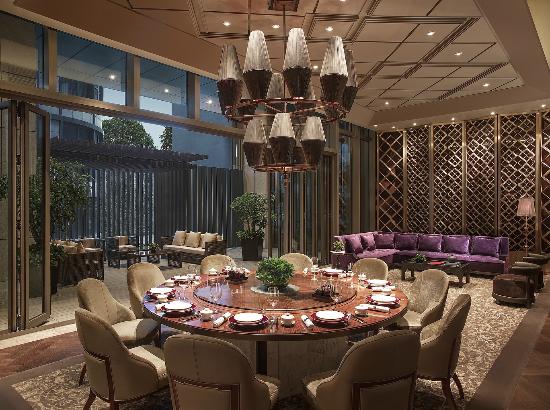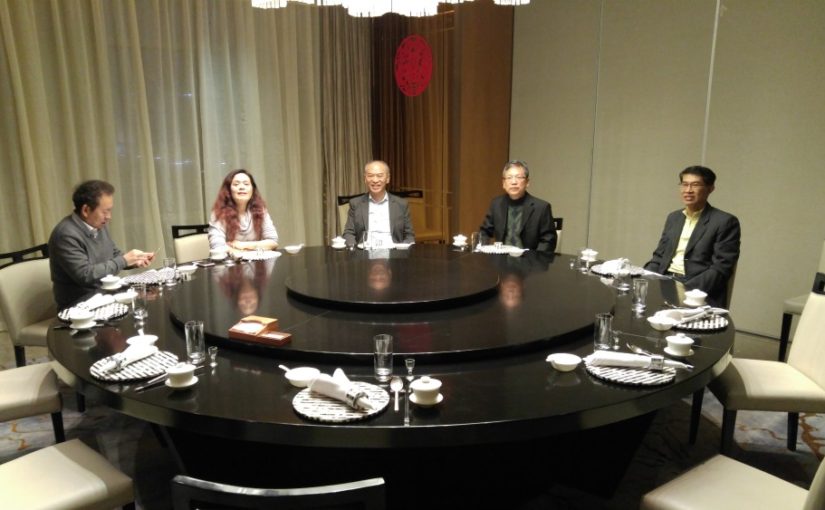This is a very detailed discussion on how a Business KTV works in China. This is a pretty large multi-part post. It was originally posted HERE, but it soon became problematic as the videos would not load and the SEO flags weren’t being picked up by the search engines. So I broke it down into smaller bite-sized posts. It’s faster to load, easier to read, and you can see all the videos without problem. Enjoy.
This is part 3 of 17.
Please kindly note that this post has multiple embedded videos. It is important to view them. If they fail to load, all you need to do is to reload your browser.
Dinner
Let’s talk about the Chinese business dinner.
You will most likely NOT eat Western food. If they offer it to you, decline. You are in China. You want to make their face as big as possible. Suggest their local delicacy, or a restaurant that cooks the same kind of meals that their home town makes. Let the factory boss select the restaurant.
Keep in mind that Chinese food is really different. Far different from any kind of “Chinese food” that you might find in the United States, for instance.
Most Chinese people don’t even know what chop suey actually is. There is nothing even remotely resembling it in China.
Since Chinese food first began being served in the USA in the 19th century, it has had generations to evolve and suit US tastes, so much so that it’s completely disconnected to traditional dishes served in China, both now and then. What Americans eat in the USA, the stuff we call “Chinese food” is wildly different from anything that you can obtain in China.
You know, most Chinese people wouldn’t recognize a plate of sticky orange chicken if it was splattered in their face. Not only the dishes, but how they are prepared, and the dish and plate sizes are all very, very different from what you would find in the States. Not to mention the “fortune cookies”.
Now, typically, the driver will either take you back to the factory where you will meet the others for the dinner, or you will drive directly to the restaurant.
In almost all cases, there will be a private room reserved in the restaurant. This is a private dining room. It will typically have a nice bathroom, a set of sofa’s and comfortable chairs, a television, and a huge circular table.

You, as the boss will be led to the room, and offered the “boss seat”. This is a chair that faces the door. You sit down, and everyone else arranges themselves around the table. The seating arrangement is hierarchical, with the various ranks of the individuals placed strategically around the table. The driver of the car(s) will also attend the meal, though they will typically be silent and not participate into any of the discussions.
You will be offered some cigarettes, just like at the factory. As the boss it is your responsibly to accept the cigarettes, or else you will lose face. Oh, yeah, it’s not healthy and all that second-hand smoke nonsense. Well, if you are doing business in China, you will need to adopt local customs. You do not want to lose face. You accept the cigarette. You take a drag. You hold it in. Tilt you head back, and stare up at the ceiling and then exhale the smoke slowly.
You need to adapt to Chinese culture. Do not lose the face of the boss. Else they might serve you dog’s head or something equally disgusting as a way to just see how low you can go.
Don’t test them.
Out of politeness, you will be offered a menu and you can select what to eat. As I typically live in the Guangzhou region, I will choose Guangzhou style food. This is easy to do, as the menu consists of full-color glossy photos of delicious food. Guangzhou food is typically steamed lightly. It is very fresh and very tasty. Now, if you were in Hunan or Sichuan, the food would be very spicy and delicious. That’s a good thing too.
Anyways, as a general rule, you order two dishes more than the number of people at the table. So, if there were six people around the table, including yourself, you would order eight dishes. (Oh, yes, everyone shares the dishes. This is quite different from the West where everyone gets their own meal.)
Being in Guangzhou, you order one thing that walks (pig, beef, mutton), one thing that flies (chicken, duck, goose), and one thing that swims (fish or seafood like shrimp). If there is a near certainty that you will go to a business KTV and you might have an all-night companion, you should make sure to order a nice large plate of oysters. Just make sure that they are fresh. Otherwise, watch out!
In general, once the three main dishes are ordered, I usually like to order vegetables, tofu, and assorted other dishes such as braised pig fat, flat bread, and maybe jellyfish. Let the other (hosting) people make suggestions and nod your head in violent agreement with their selections.
The waitress, or room manager will ask what you want and take your order. You, with your aide, will select the pictures and work out the details. While the picture might say a thousand words, there is typically a discussion of lively banter on what kind of fish, how to cook it, what spices to use, etc. Let them work out the issues.
Then, some condiments will be placed on the table. These might include peanuts infused in vinegar and spices (a personal favorite), some long white bars, that are actually pickled carrots (I love the things.), and some chicken feet. Try them all. It’s all good.
The Food
I have another post that covers the many different types of food that is available in China. For China is THE place to eat, and eat well. Of course, the ill-informed, and the media-manipulated sheeple will retort that Chinese food is terrible that they “milk rats” and eat dogs and cats. But this is just simply manipulative propaganda to keep Americans living in ignorance and fear. They take something truly rare and unique and blow it all out of proportion.
Don’t be like the ill-informed ignorant masses. There’s no need to be. If Chinese food is so bad, then why do Chinese men live an average of 15 years longer than American men? Think people, think.

Eat, for goodness sakes! Enjoy the food. Savor it. And thank the host for their very fine taste in delicious wonderful food.
Spicy Food
Oh, and one more thing, “spicy” in Chinese is “Ma” and “La”. There are, in other words, two families of spicy dishes. Both of which are way… way… out of the league of Americans. Trust me, if you think that you can handle Chinese spicy food, then ask for “zhong la” (medium spicy). What ever you do, don’t ask for “da ma la”, else your ass will be burning for a week.
There are two regional culinary areas of spicy food. They are Hunan, and Sichuan. Hunan food is cooked with a ton of hot chili peppers. It is very delicious and super flavorful, but yao oh yao! Sichuan is also tasty. They use both the Ma pepper corn seeds and the chili peppers. So delicious, and so you need to be careful in how you eat and how much you eat.
Don’t say that I didn’t warn you.
The Table
Of course, as mentioned previously, you will have your own private eating room. It will have a television, some sofas, and a large (well adorned) central table. It will probably be covered in a fresh white table cloth. In the central will be a large glass circular rotating table (a lazy Susan) where the dishes will be placed. As customary in China, you might have a box of disposable tissues or a full-on linen napkin.
You, as the guest, would sit at the head of the table. You [1] would face the door with the table between you and the door. The host would be to your right [2]. Your aides would be to your left [3]. It would sort of look a little like this…

There will be some differences in the way the food is eaten. It goes far beyond using “chopsticks” (quaizi) instead of a knife, fork and spoon. For starters, the meals are communal. They are shared meals. This differs from the West where every gets their own individual plate. Here are some of the major differences…
- Chinese usually eat communally and share their dishes with others. Westerners usually enjoy individual servings.
- Chinese cooks chop everything into bite size pieces, thus people don’t need knives to cut it, and just pick up their food with chopsticks. Westerners cook food in big pieces and serve it with knives and forks for cutting it up.
- Chinese usually don’t remove bones, and just cut them and the meat into pieces. They cook fish whole. Westerners usually eat filleted fish, and meat with whole bones, or no bones. This took me a long time to get used to. Be careful when eating, and if you eat fish, try to eat fish out of the ocean. The bones are larger and easier to remove. River and pond fish have billions of tiny, tiny bones. My wife chews it all up and spits the bones out like a sub-machine gun. Me, I have a real difficult time.
- Chinese always cook vegetables — frying, stewing, boiling, and steaming — sometimes with soy sauce, ginger, and garlic. Western salads, or just boiling vegetables in water, are virtually unknown in China. Even at home, when the wife makes me a salad, she cooks the lettuce for thirty seconds or so.
- Ingredients: Chinese cuisine uses many ingredients rarely seen in Western cuisine, like winter melons and yams, tree fungi and lotus pods, frogs and dogs, feet, tongues, ears, and all manner of internal organs, etc.
- Using spices: Chinese cooks like to add fresh/dried spices when cooking, like ginger, spring onion, mint, pepper, garlic, chilies, etc. Western cooks usually use processed spices like pepper powder, ketchup, etc.
- Seasoning bottles: You usually won’t find any salt, pepper, tomato sauce, or mustard on the table in a Chinese restaurant. But if you have breakfast at a dumpling and steamed bun shop, you can enhance the flavor with soy sauce or vinegar from a bottle poured into a dipping dish.
- Desserts: Sweet desserts are served after Western dinners, while Chinese have fresh fruit or tea for dessert. The most common is watermelon. I always love the end of the dinner watermelon. It’s almost always cut up in little pie-slice shapes.
- Round tables vs. square tables: Chinese traditionally eat at round tables, particularly family meals, as it’s convenient to share dishes with others, especially with a lazy Suzy. Roundness symbolizes unity in China. Westerners eat at square tables, which is more convenient for individual meals, with long tables for bigger groups.
- Cooking methods: Where Westerners limit themselves to boiling, frying, roasting, and baking usually, Chinese use more methods of cooking, like steaming, stewing, sautéing, braising, and quick-frying with a wok. Chinese usually use animal/peanut oil to fry food; Westerners use more butter, sunflower oil, and olive oil.
Some things I am so used to that I don’t even think about it. But the reader should note. Rice is served separately. Every person will get a bowl of rice. You eat your food over the rice and consume the rice with your bite-sized nuggets.
It is just fine and dandy to spit out bones, grizzle and other things you don’t like. You can use the plate (provided) or on the tablecloth next to the plate.
Oh Yes, before I forget… Smoking
It is very common to smoke all over China. It is rare to visit an establishment with a non-smoking sign. Usually, they will be Western restaurants such as Starbucks, McDonalds and KFC. It is VERY RUDE to tell anyone not to smoke. If you do so, you will be looked up with extreme disfavor.
If you don’t like how other people live their lives, then stay in your home nation. What ever you do, don’t be the “ugly American” and try to force your norms of behavior on others.
"Ugly American" is a pejorative term used to refer to perceptions of loud, arrogant, demeaning, thoughtless, ignorant, and ethnocentric behavior of American citizens mainly abroad, but also at home. Although the term is usually associated with or applied to travelers and tourists, it also applies to U.S. corporate businesses in the international arena.
If you are dining as part of a business trip, and you are offered a cigarette or cigar, how to accept will establish the pace at which you may or may not be accepted. To decline would be a terrible move. Oh, yeah. They will take your money for sure.
Just watch what happens when things don’t go well.
Tips
No one tips in China. You are not expected to. In fact, as the guest of honor, you will be treated with extra special care. Anything you need would be provided for you. All you need to do is ask.
Toothpicks
The Chinese use toothpicks just like they used to be in the United States (before the Bill Clinton Presidency). You will find either a toothpick container on the table or some individually wrapped toothpicks for your use. Go ahead and use them. When using them you cover your mouth with one hand while you pick at your teeth. That is the Asian technique that is common throughout Asia.
Drinking
As mentioned previously, you would be drinking hard alcohol during dinner. This would typically be “white wine”, “red wine” or Whiskey. If you drink Whiskey, XO, or VSOP it will (typically) be mixed with green tea with ice. Green tea is actually unsweetened green tea that is mass produced and dispensed in bottle much like soda is in the States.
By the time dinner is over, all of the hard booze will be gone. Thus, when you go to the KTV you will start a while new round of drinking. Often, this is simply beer or, maybe some more VSOP. You need to be able to control and monitor your drinking. Remember…
This is work. While that are pleasurable aspects to these fun games, it is serious business and you do need to have your wits about you.
Sometimes…
Sometimes you might have the dinner in the same building as the business KTV. This will be a one-place-does-it-all environment. You would be welcomed on the first floor and maybe go to the third floor for dinner. Then to the KTV on the 6th floor and then to the hotel rooms on the 11 or 12th floors.
In this case, there might be groups of gals led into your dining room. Then they might wear their costumes and share a bottle of wine or two with you and your associates. This is a nice light time and lets you get into the spirit of the night. It would be along the lines of this…

If you want to return to the start of this series, please go HERE.
Do you want more?
I have more posts in my Business KTV Index here…
Business KTV'sThe Chinese Business KTV Experience




















Articles & Links
- You can start reading the articles by going HERE.
- You can visit the Index Page HERE to explore by article subject.
- You can also ask the author some questions. You can go HERE to find out how to go about this.
- You can find out more about the author HERE.
- If you have concerns or complaints, you can go HERE.
- If you want to make a donation, you can go HERE.


